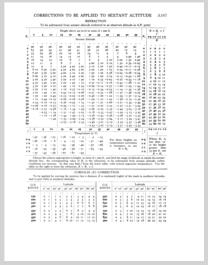
NavList:
A Community Devoted to the Preservation and Practice of Celestial Navigation and Other Methods of Traditional Wayfinding
Re: The development of bubble sextants
From: UNK
Date: 2009 Aug 15, 02:27 +0200
From: UNK
Date: 2009 Aug 15, 02:27 +0200
Well, of course, coriolis is a fictional acceleration. You calculate it with the formula: Z (coriolis correction) = .0262 times the ground speed in knots times the sine of the latitude. What you are actually doing is correcting for the change in the orientation of the latitude- longitude grid as the plane moves over the surface of the earth which makes it appear that the vertical was deflected as computed by the formula. You make the adjustment by shifting the LOP or the AP or the final fix to the right (in the northern hemisphere) of the track over the ground the amount calculated by the formula. See attached table. gl douglas.denny@btopenworld.com wrote: > Three points: > > 1)The curvature of the upper bubble chamber lens is equal to that of the focal length of the lens/mirror arrangement so the bubble is in focus at all times in all positions. > > 2) The bubble chamber is circular so the bubble chamber/sextant can have lateral movement (roll) as well as the important movement in pitch, to allow some degree of lateral movement not easily possible in a straight (standard) bubble tube arrangement. This is probably why the straight tube bubble chamber was abandoned on marine sextants, or at least, not developed further in favour of other methods. > > 3) The argument seems to be - if I have it right: to attempt to eliminate side accelerations affecting the bubble. You cannot escape side (horizontal) accelerations affecting the apparent gravitational vertical whatever you do, as the 'compensating mechanisms' will be referenced to the local gravitational field too. Even if some hysteriesis is present between bubble and 'compensator' mechanism, both will have to come to the same conclusion as to where the gravitational field is pointing. In other words you are back to square one. > > Eary type aircraft artificial horizons are such a mechanism that uses local gravitational field to provide an horizon (or hence vertical whichever you prefer) - they have a long time constant errecting mechanism using small pivoted vanes on four points around the gyro. The vanes 'dangle' downwards due to gravity and provide precessional forces to bring the gyro to an horizontal plane. > > Coriolis force is such an example of horizontal acceleration that cannot be eliminated; it has to be allowed for - luckily because it is a constant feature and thus a known quantity. > > Douglas Denny. Chichester. England. > > > > > > --~--~---------~--~----~------------~-------~--~----~ NavList message boards: www.navlist.net Or post by email to: NavList@navlist.net To , email NavList-@navlist.net -~----------~----~----~----~------~----~------~--~---







